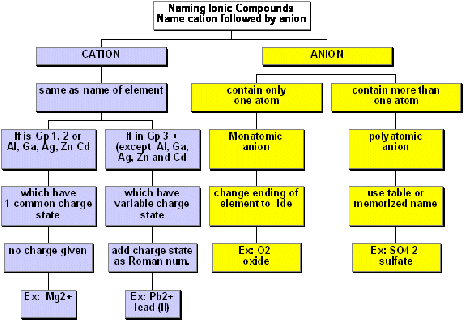Precipitation Reactions
Precipitation reactions occur when different aqueous solutions (usually of salts) are mixed, and a solid substance results. Remember solutions are homogeneous mixtures in which each part of the solution has the same composition. A solution can be colored (such as a blue copper sulfate solution) but it is always clear. Clear means that the solution is transparent, not cloudy, turbid, translucent, or opaque.
Most of the precipitation reactions that we will deal with involve aqueous salt solutions. Remember salts are compounds which consist of metal cations like Na+, Ca2+, Cu2+ (or the one nonmetal molecular ion that we have discussed, ammonium - NH4+) ionically bonded to nonmetal anions such as Cl-, (or molecular anions such as hydroxide - OH-, sulfate - SO42-, phosphate - PO43-, nitrate - NO3-, and carbonate - CO32-), dissolved in water. Salts can be divided into two types: those soluble in water, and those insoluble in water. You should know some simple solubility rules which will allow you to know which salts are soluble in water.
nitrate NO3- salts are soluble
salts containing Group 1 metals (Li, Na, K, 1+ charge) and NH4+ are soluble
most Cl-, Br-, and I -salts are soluble, with the notable exceptions of salts that contain silver, Ag+ and lead, Pb2+
most sulfate SO42- are soluble with the exceptions of salts containing barium, Ba2+, Pb2+ and Ca2+
most hydroxides OH- are just slightly soluble, with the exceptions of the very soluble NaOH and KOH
most phosphates PO43- and carbonates - CO32- are only slightly soluble.
Precipitation reactions occur when different salt solutions are mixed, which result in the formation of an insoluble salt, or precipitate. When precipitation occurs, the cation of one of the soluble salts interacts with the anion of the other soluble salt to form an insoluble salt. The other ions which remain soluble are called spectator ions.. Consider the following example when aqueous solutions of NaCl and AgNO3 are added to each other. A white cloudy precipitate forms. What is the likely product that formed a precipitate? Consider all the ions in solution. If the positive ions approached each other, they would repel, so we can't form compounds like NaAg. The same is true of the negative ions. Ions of opposite charge can attract each other so we could reform NaCl and AgNO3. However, these are soluble salts and would immediately dissociate again into individual ions. The other possibilities are AgCl and NaNO3. The later would likewise dissociate since we know that Na and NO3 are soluble. The only alternative is AgCl. We can write a series of chemical equations to explain these interactions:
molecular equation: write down the species as molecules as below-
NaCl (aq) + AgNO3 (aq) --> AgCl (s) + NaNO3 (aq) where the (aq) for aqueous implies that the salt is in solution as is soluble.
ionic equation: write down the species as they actually occur in the solution:
Na+(aq) + Cl-(aq) + Ag+(aq) + NO3-(aq) --> AgCl(s) + Na+(aq) + NO3-(aq)
net ionic equation: remove identical ions that appear on both sides fo the ionic equation that act as "spectators" in the reaction. They are called spectator ions.
Ag+(aq) + Cl-(aq) --> AgCl(s).
(From '08):
New 2/13/08: A note on nomenclature.
In the graph, you will see reaction mechanisms used curved arrows for bond making and breaking. The arrows always start with a nonbonded pair of electrons on the base which is attracted to a dH+ on the acid or proton donor. Hence the attack starts with the base. That seems to be the opposite to the notion that an acid "actively" donates a proton. From the perspective of the H+ on the acid, the H+ moves (is donated) to the base. From the perspective of the lone pair on the O of the base, the base takes (accepts) the H+.
To simplify this description, let's come up with a different description of an acid and base that indicate action initiated by the base (see mechanism above using curved arrows).
ACID: molecule from which a proton (H+) is pulled by accepting an electron pair to a Hd+
BASE: molecule which attacks and bonds to a proton (H+) by donating an elecron pair to a Hd+.
When these substances are dissolved in water, no light is observed when electrodes are placed in the water. This implies that are no ions in solution. From these examples, we can tentatively conclude that covalently bonded species don't dissolve in water to form ions. This makes sense in that pure H2O itself, a molecule held together by polar covalent bonds, did not conduct electricity in our experiment.
But if we did the same experiment with HCl(aq) added to water, a bright light is observed.
Here is the link:)
Conductivity
Well, I'm done with my science rant.
Ja ne, osuwari.

KampfgruppeLehr
Well, actually H2O itself forms ions : 2 H2O = H3O+ + HO- . This is called autoprotolysis. Everything else is correct. You could be a teacher ;-) Maybe is it your future job ?
osuwari
I doubt it, but thank ya for the comment. I just don't tend to use my intelligence as I should. Besides, that day, I felt nerdy.
xD